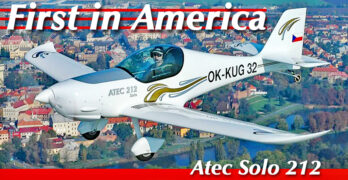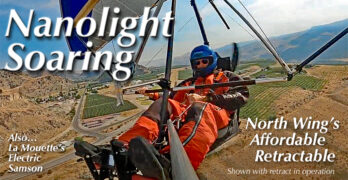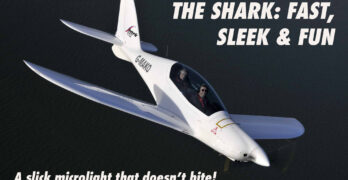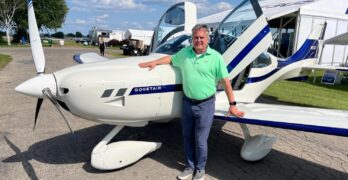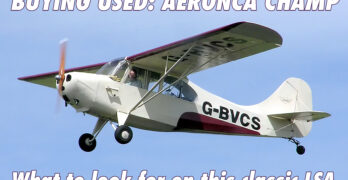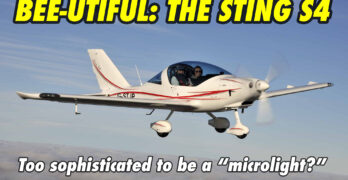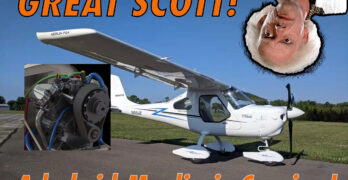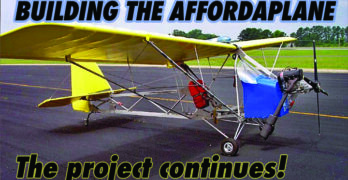Lined up on the runway, I open the throttle to the stop. The Dynamic surges forward, my right thumb presses a small button at the base of the throttle quadrant and I push the lever further forward. In an instant there’s 15% more thrust and the speed tape really starts to roll. Ease back on the stick and we’re airborne after a very short ground roll and climbing away at well over 1200 fpm.
Flaps up, and 20 seconds later we’re passing through 400 feet, I pull the power back past the detent and the turbocharger control unit (TCU) reduces boost to 35 inches of manifold pressure. I then lower the nose, dial the prop rpm down to 5500 engine rpm and note the VSI is still showing around 1000 fpm before swinging the shapely spinner onto a south-easterly heading. Already I can see that the field of view is phenomenal and feel that the handling is crisp and taut.
Search Results for : Electric
Not finding exactly what you expected? Try our advanced search option.
Select a manufacturer to go straight to all our content about that manufacturer.
Select an aircraft model to go straight to all our content about that model.
Go Solo! Atec’s Solo 212 Let’s You Fly Yourself in Style, Yet It’s Affordable
Was this aircraft the star of MAX, the airshow? Maybe. “It drew a lot of attention,” said a company representative, “a sleek taildragger single seater with a 912 up front.” That it was accented with red inside and out helped, as proven by big auto companies that spend millions to advertise red cars when they want to catch your eye. (Updated 2/27/24: new images at bottom)
Atec Solo 212 is the name of the airplane. It will not be their top seller but for plenty of pilots (me included) this was a charmer. Plus, let me spill the beans on its affordability. I don’t know your budget but this beauty could be had, in America, for $100-110,000 reported RT Aviation partner Todd Livingston a couple weeks after MAX ’24 concluded. That price won’t work for everyone, I know, but it’s half the cost of many “reasonably” priced SLSA in fall 2024.
Superlight… Aircraft that Weigh Less than You Do and Are More Affordable
My title avoided the word “ultralight” even if these two aircraft qualify. The American entry can readily fit FAA’s Part 103 as an Ultralight Vehicle, freeing the pilot from having to register the aircraft, or have a pilot certificate, or possess any sort of “medical” to fly it.
The French entry cannot qualify as a Part 103 but I find it surprising this super lightweight machine is a two seater and can be electric-powered. It is not available in the USA at this time but the brand once had a strong American presence. I owned one of their light trikes myself a couple decades back. Here’s a full review from 2004.
Welcome to brief reviews of two very light weight-shift aircraft, North Wing’s SkyMax and La Mouette’s Samson. (La Mouette is French for seagull.)
That these two are also more affordable may come to the rescue of budgets under assault by persistent inflation.
Where Is the World Headed with Low-Altitude Airspace Freedom?
With the excitement of EAA’s summer celebration of flight — AirVenture Oshkosh 2024 — slowly beginning to fade from headlines, this might be a good time to broaden our outlook.
AirVenture features aircraft from everywhere and of every conceivable type. It’s a veritable smorgasbord of airplane-examining pleasure and thoroughly covers nearly every aspect of aviation, from foot-launched powered paragliders to multiengine warbirds and everything in between.
Some were searching for the newest innovations, by which such attendees may mean drones, UAVs, multicopters, eVTOLs… whatever you might choose to call them. Finding these machines at KOSH was much less obvious perhaps because the truth is, Yankee pilots remain focused on aircraft they can get in and fly using their own skills.
American Dream
We live in a country of great aviation freedom and lots of wide open spaces. Those of us interested in flying light aircraft for the sheer enjoyment of it can do so in way the rest of the world can barely comprehend.
Flight Review: Riding the Shark!
“You never get a second chance to make a first impression” is a wise old saw, and my initial impressions of the Shark were all very positive. Some aircraft look like they’re moving even when they’re standing still, and the Shark definitely falls into this category. From the tip of the sharp-looking spinner to the top of the swept-back fin, it’s easily the sexiest-looking microlight I’ve ever seen. Indeed, my first thought is that it looks rather like a scaled-down PC-21.
Walking around the aircraft, I note that the 100-hp Rotax 912S is very tightly cowled, and that access to the engine bay is adequate, but not outstanding, as quite a lot of Camloc fasteners need to be undone to remove the entire cowling for a full engine inspection. There’s a large electrically actuated NACA scoop in the bottom half which supplies air to the oil cooler and radiator, and small intakes in the top half on both sides of the spinner for cooling the cylinders.
Scissortail Aerosport Unveils Two-Place “MOSAIC-Ready” Gogetair G-750 At AirVenture
Scissortail Aerosport company, out of Tulsa, Oklahoma, imports sleek composite aircraft from Slovenia. Last year, they brought a sleek four place low wing to AirVenture that was well-received. This year, they imported an even sleeker and, dare we say, sexier looking, two place speedster that promises to be “Mosaic ready.” Named the GOGETAIR G-750, this little sportster trues out at 138 knots at 10,000 feet and stalls at 54 knots.
The two place Gogetair G-750 that Scissortail brought to AirVenture flies behind a Rotax 914 Turbo and a Woodcomp electric variable-pitch prop. Scissortail’s President, Shannon Hankins, states that the customer can also order a Rotax 915 and a hydraulically powered MT constant speed prop. The panel wears a Dynon HDX EFIS, but can be ordered with the Garmin G3X. This design features a fuselage roll safety cage and a whole airframe parachute. The Gogetair G-750’s most attractive trait, however is it’s eye-catching design, sporting swept wing tips and gull wing doors.
Buying Used: Aeronca Champ—A Plane That Deserves Your Respect
The Aeronca Champion might be the Rodney Dangerfield of light aircraft. The plane, which has historically played second fiddle to the Piper Cub, doesn’t get the respect it deserves, according to its fans. “Take all the light planes from that era and look at which offers the best characteristics… I would place the Champ at the top,” argues John Weigel, a Boston area pilot who twice flew a Champ from coast to coast. “I love the Cub,” he says, “but the Champ has no bad qualities. And if I’m taking someone up with me, I’ll take it over other similar planes every time.”
When compared to the Cub, as well as the Luscombe, Taylorcraft and Cessna 120 and 140, among other tailwheelers, the Champ is easier to get into, offers more comfort, has better visibility, more forgiving landing gear and is probably the better training/low-time pilot aircraft. All are good reasons to consider a Champ if you’re looking for a simple, relatively inexpensive and fun to fly aircraft.
Flight Review: The Sleek Sting S4
“Look at that groundspeed!” I exclaimed, pointing at the Garmin EFIS. “Our TAS is nearly 125 knots, which means we’ve got a 60 knot headwind straight on the spinner!” “Can you imagine being up here in a traditional microlight?” asked the Sting’s owner, John Palmer. “No, because not only would I be scared out of my mind at the prospect of having to land, but right now we’d practically be going backwards!” I said.
I’ve written before about just how capable and potent the new breed of light sport microlights is, and several of the aircraft I’ve tested recently are not only comparable to traditional GA types, but are demonstrably superior. An excellent representative of this new breed of speedy sport planes is the Sting S4, from Czech airframer TL Ultralights.
As I wait at Saltby for John to arrive in the Sting, I’m aware that it’s extremely windy, and that if I’d told someone that I was planning on flying a microlight in such conditions, they’d probably think I was mad—or suicidal.
Look Out — A Hybrid Merlin is Coming!
First introduced in Europe in 2013, the all aluminum single seat enclosed cabin Merlin LSA has sported a variety of engines, including a Rotax 582, a specially built four stroke V-twin and even an electric motor. In fact, the Merlin airframe has served as a test bed for all kinds of propulsion and aerodynamic innovations. At AirVenture 2023, Aeromarine chief designer Chip Erwin even showcased a Merlin model with twin propellors imbedded in the wings. Erwin promises an even bigger surprise at Oshkosh later this month: a common-sense hybrid propulsion system for the Merlin.
Erwin, who has done work for the Air Force Research Lab in Dayton, Ohio, has developed a parallel hybrid drive system for light sport aircraft that utilizes an electric motor to add to thrust generated by a
piston engine during takeoff and climb, but shuts down during cruise. He points out that a major limitation of all electric aircraft is the need to lug around a heavy battery capable of providing thrust for a limited period of time.
Building the Affordaplane, Part 3
In the previous installment, I described construction details for the fuselage section of the Affordaplane ultralight project. Now let’s look at construction of the empennage and wing assemblies. Remember, this is a plans-only type of build using off-the-shelf materials and tools intended for a novice builder. Keep this objective in mind when reviewing the construction and design details. A complete free video series on YouTube shows each step of this construction.
The components of the empennage (rudder, elevator, vertical and horizontal stabilizers) are all formed from 1-inch 6061-T6 aluminum tubing. These tubes must be bent into their respective shapes, matching template patterns drawn on your workbench. (Use some craft paper for this!) What is the easiest way to form these simple bends? I found that using an electrician’s conduit bender did the job nicely. With a little practice, each tube was formed to the proper shape and then fitted with a gusset to join its ends.
- « Previous Page
- 1
- …
- 8
- 9
- 10
- 11
- 12
- …
- 67
- Next Page »



